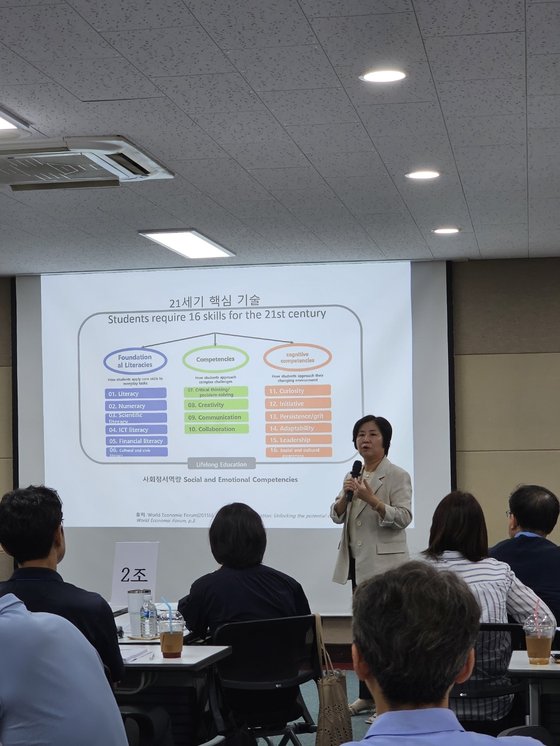Seoul National University College of Medicine. News 1″ data-type=”article”/>
Seoul National University College of Medicine. News 1
Seoul National University medical students take the ‘Human, Society, and Medicine’ lecture every year, which is a required subject for their major, from the first year of the pre-medical department to the fourth year of the general department. Lectures cover a wide range of topics, including the public nature of health care, social determinants of health, and the health care system.
Professor Yoo Seong-ho of the Department of Forensic Science at Seoul National University, who was in charge of running the class, said, “This is a class that integrates various humanities and social science lectures to think about and evoke the essence of various doctors, such as the doctor’s role as seen by society and the doctor’s role as an intellectual.” “We can deal with a variety of medical issues,” he said.
Domestic medical schools also have a humanities and social sciences curriculum to develop the basic knowledge of medical students. However, it is pointed out that in most medical schools, it is not easy to organize such classes, and since they are concentrated in specific grades, the actual educational effect is minimal.
Humanities and social sciences classes focused on lower grades
As a result of Professor Seunghee Lee of the Department of Medical Education at Seoul National University investigating the curricula of 29 pre-medical schools and 34 medical departments (main departments) nationwide, a total of 532 classes (as of 2022) were opened as ‘Humanities and Social Medicine’ courses. Humanities and social medicine is a field of study that deals with human disease and health from psychological, social, and cultural aspects.
When looking at medical school lectures, this includes classes that cover areas other than medical knowledge, such as ▶ language ▶ history ▶ art ▶ ethics ▶ reading, writing, and discussion ▶ medical history ▶ philosophy of medicine ▶ clinical psychology.
![‘What kind of doctor will I be?’ Why is this type of study not included in regular courses? [닥터로드] ‘What kind of doctor will I be?’ Why is this type of study not included in regular courses? [닥터로드]](https://pds.joongang.co.kr/news/component/htmlphoto_mmdata/202410/26/a7cdd45a-282e-46a3-b2f3-9700d95cdc08.jpg)
Proportion of classes related to humanities and social sciences among domestic medical school classes. Even within the department, most classes end in the lower grades, and there are no classes at all in the fourth grade, when the national exam is taken. Provided by Professor Seunghee Lee
The pre-graduate department organized 6.3 humanities and social sciences classes over 2 years, and the main department organized 10.2 humanities and social sciences classes over 4 years. There are about 2 to 3 per grade. The problem is that most humanities and social sciences classes are focused on the lower grades. There were also classes offered only for specific grades, such as reading, writing, debate, international medicine (first year of general studies), and history (second year of general studies).
Professor Lee said, “I think that many medical schools can cover humanities, social sciences, and medicine-related content through liberal arts courses within the premedical department.” He added, “In medical departments (main departments), humanities, social sciences, and medicine curricula are mainly organized in the lower grades, and national examinations such as medical law are conducted. “Related subjects are organized in upper grades,” he explained.
Professor Gyu-mi Park’s research team at Chung-Ang University’s Curriculum Innovation Center said in ‘A study on perceptions of the reform of the integrated 6-year medical school system’ that “In the current curriculum, basic knowledge such as sense of duty, dedication, and respect for life as a doctor is taught, but most of it is focused on the 2 years of pre-med. He pointed out that “sufficient education is not provided after promotion to the medical department.”
“I can’t think deeply because I’m busy playing during pre-med and studying during regular school.”

A scene where Seoul National University medical education professor Lee Seung-hee explains to medical school professors the type of talent that should be considered important in the selection process. Professor Lee said, “It is also important for each university to establish an accurate image of talent and create a selection and curriculum tailored to that.” Provided by myself
Medical school officials said that because the major class schedule is tight, it is not easy to organize basic knowledge education. Professor Yoo Seong-ho also said, “When introducing the class, professors were reluctant at first because of the difficulty of having to omit major medical school subjects.”
There are also criticisms that motivation to learn basic knowledge subjects is low among medical students. Professor Seunghee Lee said, “There was a student evaluation that it was not effective because each medical school lacked the manpower to organize and organize the curriculum, and the classes were focused on theory.”
There are also arguments for integrating pre-graduate and general courses into a six-year system. The purpose is to operate the curriculum flexibly, including consistently organizing practical, theory, and knowledge classes over the course of six years. In relation to this, the Ministry of Education revised and promulgated the Enforcement Decree of the Higher Education Act in February, which allows each university to freely determine the medical school curriculum. The idea is that the university should run the 6-year program on its own, rather than dividing it into 2 years of pre-med and 4 years of general education.
A professor of medicine at a private university in a non-metropolitan area said, “When I was in pre-medical school, I was busy playing, and when I got into the main department, I was so busy studying that I couldn’t think deeply about what I wanted to do or what kind of doctor I would become in the future.” He added, “The integrated 6-year system has a diverse class composition. “If the number increases, there may be graduates entering essential medical fields or medical science fields,” he said.
※This project was supported by the Press Promotion Fund raised through government advertising fees.

